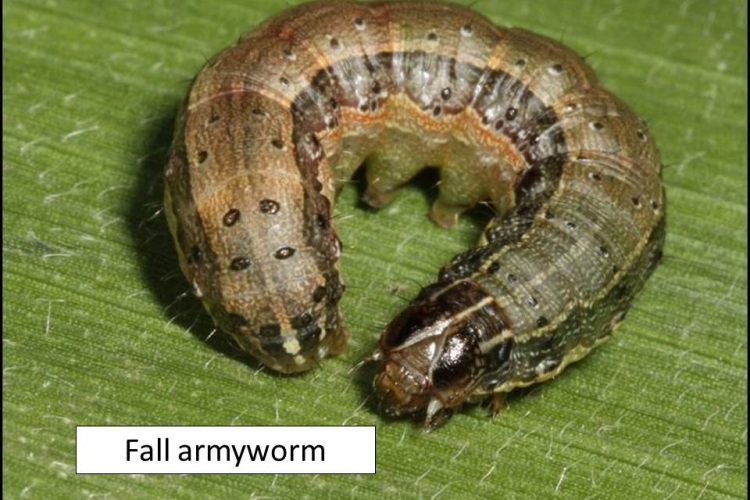Fall Armyworm (Spodoptera frugiperda): Invasive species found in Karnataka
In News
The Indian Council for Agricultural Research (ICAR) has sounded the alarm after the invasive agricultural pest Fall Armyworm (Spodoptera frugiperda) was discovered in Karnataka . A major maize pest in North America, the Fall Armyworm arrived in Africa in 2016. It is the larval life stage of a fall armyworm moth. The Karnataka finding is the first report of the pest in Asia. In India, Andhra Pradesh and Tamil Nadu are at immediate risk. And even though the pests reported in Shivamogga and Chikballapur, Karnataka, are only feeding on maize and sorghum at the moment, they are likely to spread to other crops.
What are invasive species?
According to Convention on Biodiversity ,"An invasive alien species (IAS) is a species that is established outside of its natural past or present distribution, whose introduction and/or spread threaten biological diversity.
What Makes a Species "Invasive"?
An invasive species can be any kind of living organism—an amphibian (like the cane toad), plant, insect, fish, fungus, bacteria, or even an organism’s seeds or eggs—that is not native to an ecosystem and causes harm. They can harm the environment, the economy, or even human health. Species that grow and reproduce quickly, and spread aggressively, with potential to cause harm, are given the label “invasive.” An invasive species does not have to come from another country.
How Invasive Species Spread?
Invasive species are primarily spread by human activities, often unintentionally. People, and the goods we use, travel around the world very quickly, and they often carry uninvited species with them. Ships can carry aquatic organisms in their ballast water, while smaller boats may carry them on their propellers. Insects can get into wood, shipping palettes, and crates that are shipped around the world. Some ornamental plants can escape into the wild and become invasive. And some invasive species are intentionally or accidentally released pets. In addition, higher average temperatures and changes in rain and snow patterns caused by climate change will enable some invasive plant species to move into new areas. Insect pest infestations will be more severe as pests such as mountain pine beetle are able to take advantage of drought-weakened plants.
Threats and Impacts
An analysis of the IUCN Red List shows that they are the second most common threat associated with species that have gone completely extinct, and are the most common threat associated with extinctions of amphibians, reptiles and mammals. Invasive species cause harm to wildlife in many ways. When a new and aggressive species is introduced into an ecosystem, it may not have any natural predators or controls. It can breed and spread quickly, taking over an area. Native wildlife may not have evolved defenses against the invader, or they may not be able to compete with a species that has no predators.
The direct and indirect threats of invasive species include
- preying on native species, outcompeting native species for food or other resources, causing or carrying disease, and
- preventing native species from reproducing or killing a native species' young.
- Invasive species can change the food web in an ecosystem by destroying or replacing native food sources. The invasive species may provide little to no food value for wildlife.
- Invasive species can also alter the abundance or diversity of species that are important habitat for native wildlife.
- Additionally, some invasive species are capable of changing the conditions in an ecosystem, such as changing soil chemistry or the intensity of wildfires.
Recent initiatives to curb invasive species
In 2010 almost all of the world’s governments adopted the Convention on Biological Diversity Strategic Plan for Biodiversity, which included 20 headline ‘targets’ referred to as the Aichi Targets.
“Target 9: By 2020, invasive alien species and pathways are identified and prioritized, priority species are controlled or eradicated and measures are in place to manage pathways to prevent their introduction and establishment” Convention on Biological Diversity
This international commitment was re-affirmed in 2015 through the 2030 Agenda for Sustainable Development which includes 17 goals (SDGs) each with specific targets. The SDGs have nature woven throughout acknowledging that nature is fundamental to human well-being. One of the SDGs #15 Life on land, has a target focusing specifically on Invasive alien species.
“By 2020, introduce measures to prevent the introduction and significantly reduce the impact of invasive alien species on land and water ecosystems and control or eradicate the priority species”
IUCN ‘s initiative
IUCN is focused primarily on achieving Aichi T9. To do this IUCN has been working in three major areas,
1. providing scientific knowledge,
2.engaging in and supporting national and regional policy development, and
3. action on the ground.
Invasive Species Specialist Group (ISSG)
Much of the work IUCN undertakes through the Invasive Species Specialist Group (ISSG), which is a global network of scientific and policy experts on invasive species. Organized by the IUCN Species Survival Commission, the ISSG aims to reduce threats to natural ecosystems and the native species they contain by increasing awareness of invasive alien species and ways to prevent, control or eradicate them.
The Global Invasive Species Database
The Global Invasive Species Database (GISD) is a free, online searchable source of information about alien and invasive species that negatively impact biodiversity. The GISD aims to increase public awareness about invasive species and to facilitate effective prevention and management activities by disseminating specialist’s knowledge and experience to a broad global audience. It focuses on invasive alien species that threaten native biodiversity and natural areas and covers all taxonomic groups from micro-organisms to animals and plants.
The Global Register of Introduced and Invasive Species
It compiles annotated and validated country-wise inventories of introduced and invasive species. The development and population of the GRIIS was undertaken by the ISSG within the framework of the CBD Global Invasive Alien Information Partnership.


 IAS -2025 Prelims Combined Mains Batch - III Starts - 14-04-2024
IAS -2025 Prelims Combined Mains Batch - III Starts - 14-04-2024